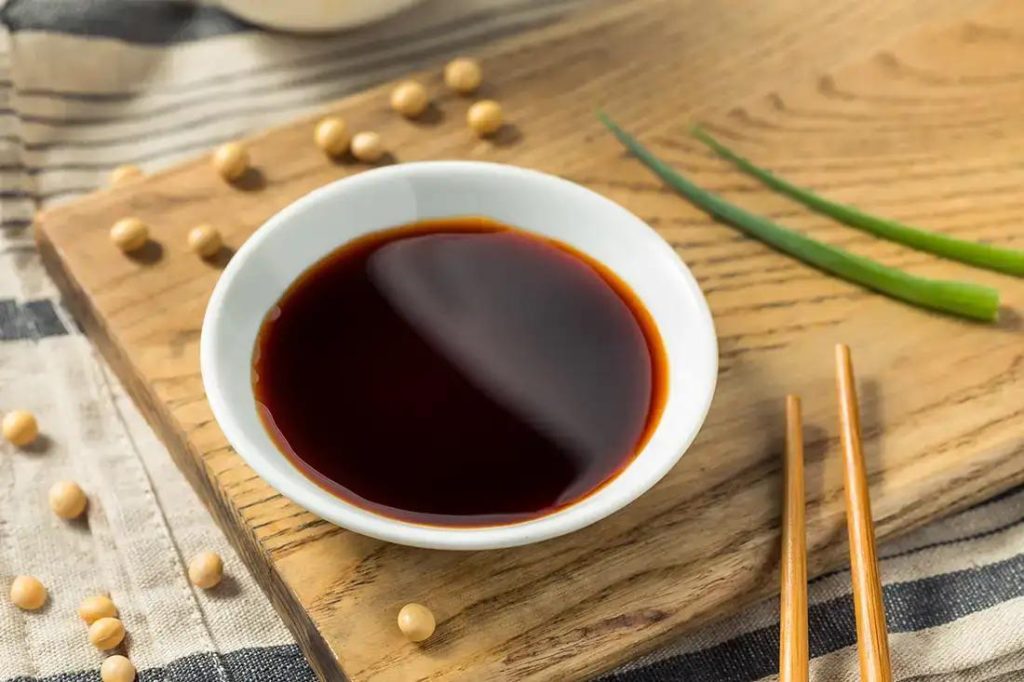Table of Contents
For those who follow a gluten-free diet due to celiac disease or other health concerns, finding suitable alternatives to commonly used condiments can be challenging. Traditional soy sauce contains wheat, making it a no-go for those who need to avoid gluten. That’s where this Wheat-Free Soy Sauce Recipe comes in!
This homemade version is a simple, delicious, and gluten-free alternative to regular soy sauce. Whether you’re stir-frying, marinating, or simply adding flavor to your meals, this soy sauce substitute ensures you don’t miss out on the savory, umami taste that soy sauce brings to your favorite dishes. With just a few ingredients, you can make this sauce in the comfort of your own kitchen and enjoy it in various recipes.

How to make Wheat-Free Soy Sauce
Ingredients
Here’s everything you’ll need to make your own Wheat-Free Soy Sauce:
- 1 cup coconut aminos – This is the base of the recipe and a gluten-free alternative to soy sauce. Coconut aminos have a naturally sweeter taste compared to traditional soy sauce.
- 1 tablespoon molasses – Adds richness and a bit of depth to balance the flavor.
- 1 teaspoon apple cider vinegar – For a bit of acidity and tang, which mimics the complexity of soy sauce.
- 1 clove garlic, minced – Garlic adds a lovely layer of savory flavor.
- 1/2 teaspoon ginger powder – Gives warmth and a subtle kick to the sauce.
- 1/4 teaspoon onion powder – Complements the garlic and boosts the savory notes.
- 1/4 teaspoon sea salt – Salt enhances the umami flavor, making it taste more like traditional soy sauce.
- 1 cup water – Used to adjust the consistency and tone down the strength of the sauce, making it perfect for cooking or seasoning.

Instructions for making Wheat-Free Soy Sauce
Step 1: Combine the Ingredients
In a medium-sized saucepan, combine the coconut aminos, molasses, apple cider vinegar, minced garlic, ginger powder, onion powder, sea salt, and water. Stir the mixture thoroughly to ensure all the ingredients are well blended.
Step 2: Simmer the Sauce
Place the saucepan over medium heat and bring the mixture to a gentle simmer. Allow it to simmer for about 10–15 minutes, stirring occasionally. This allows the flavors to meld together while slightly thickening the sauce.
Step 3: Adjust the Flavor
After simmering, taste the sauce. If you prefer a saltier or more intense flavor, you can adjust by adding a bit more sea salt or molasses. If you find it too strong, add a splash of water to dilute it to your liking.
Step 4: Cool and Store
Remove the saucepan from the heat and let the sauce cool to room temperature. Once cooled, pour the sauce into an airtight container or glass jar and store it in the refrigerator. The sauce can last for up to two weeks in the fridge. Be sure to give it a shake before each use as some ingredients may settle.
Tips for Making the Perfect Wheat-Free Soy Sauce
Here are a few helpful tips to ensure your Wheat-Free Soy Sauce turns out perfectly every time:
- Use High-Quality Coconut Aminos: Since coconut aminos serve as the base for this recipe, using a high-quality brand will make a noticeable difference in the flavor. Opt for organic or minimally processed coconut aminos for the best results.
- Adjust to Your Taste: Everyone’s palate is different! If you prefer a slightly sweeter sauce, you can increase the amount of molasses. For a saltier finish, add a bit more sea salt. Don’t hesitate to tweak the ingredients until the flavor is exactly how you like it.
- Let it Simmer Slowly: To bring out the deep, rich flavors of the soy sauce substitute, let the sauce simmer slowly. Rushing the process can prevent the ingredients from blending well together. Low and slow is the key!
- Don’t Skip the Garlic and Ginger: These two ingredients are essential for adding depth and that signature umami taste you’re looking for. Freshly minced garlic can be substituted for garlic powder if you want a more pronounced flavor.
- Store in a Glass Jar: To maintain the freshness of your wheat-free soy sauce, store it in a glass container with an airtight lid. This will help prevent it from absorbing unwanted odors from your refrigerator.
- Shake Before Each Use: Over time, the ingredients may settle, so give the jar a good shake before using your soy sauce substitute to ensure even flavor distribution.

Where and How to Use Wheat-Free Soy Sauce
The beauty of this Wheat-Free Soy Sauce is its versatility. Just like traditional soy sauce, it can be used in countless dishes, making it an excellent pantry staple for those avoiding gluten. Here are some ideas on where and how to use it:
- Stir-Fries: Whether you’re cooking vegetables, chicken, or beef, this soy sauce substitute is perfect for stir-frying. The sauce enhances the dish with savory, umami flavors that elevate your vegetables and proteins.
- Marinades: Use the wheat-free soy sauce as a base for marinades. Simply mix it with ingredients like ginger, garlic, and a bit of oil to create a delicious marinade for chicken, pork, tofu, or even fish.
- Dipping Sauce: Serve your wheat-free soy sauce as a dipping sauce for sushi, dumplings, or spring rolls. You can also mix it with a bit of rice vinegar and sesame oil to create a balanced dipping sauce.
- Salad Dressings: Add a splash of this gluten-free soy sauce to your homemade salad dressings. Its salty, savory profile pairs well with citrus-based vinaigrettes or tahini-based dressings.
- Soups: Enhance the flavor of your soups with this wheat-free soy sauce. It works beautifully in broth-based soups like
Marry Me Chicken Soup or miso soup or as a secret ingredient in rich, hearty ramen. - Rice and Noodles: Drizzle the soy sauce substitute over rice or noodles to give them a burst of flavor. It’s an excellent addition to fried rice, lo mein, or even a simple bowl of steamed jasmine rice.
- Glazes: Create a rich, sticky glaze by combining your wheat-free soy sauce with honey or maple syrup. Brush it onto grilled meats or roasted vegetables to achieve that mouthwatering caramelized finish.

Ingredients Substitutes for Wheat-Free Soy Sauce
If you don’t have all the ingredients for this wheat-free soy sauce recipe or are looking for other alternatives, here are some excellent substitutes you can try:
- Tamari Sauce: Tamari is a Japanese soy sauce that is traditionally brewed without wheat, making it a popular gluten-free alternative. It has a similar flavor profile to regular soy sauce but tends to be slightly less salty. You can use tamari in place of soy sauce in a 1:1 ratio for any recipe.
- Coconut Aminos: Coconut aminos are already the star ingredient in this recipe, but if you’re short on time, you can use it on its own as a substitute for soy sauce. It’s gluten-free, soy-free, and has a naturally sweet and salty taste that works well in most dishes.
- Liquid Aminos: Another excellent gluten-free alternative, liquid aminos is derived from soybeans and contains no wheat. It’s similar to soy sauce but tends to be slightly milder in flavor and less salty. This makes it a good substitute for soy sauce in stir-fries, dressings, and marinades.
- Worcestershire Sauce: Although not a perfect match, Worcestershire sauce can be a suitable replacement in certain recipes. It has a tangy, savory flavor that works well in marinades and sauces. Just be sure to check the label, as some brands of Worcestershire sauce may contain gluten.
- Balsamic Vinegar: In a pinch, balsamic vinegar can be used as a substitute for soy sauce in salad dressings or glazes. Its rich, slightly sweet flavor won’t perfectly mimic soy sauce, but it does add complexity to a dish. It’s particularly good in stir-fries or when mixed with garlic and ginger for a quick marinade.
Each of these substitutes can bring unique flavors to your recipes while keeping them gluten-free, making them excellent alternatives depending on the dish and your taste preferences.
Frequently Asked Questions (FAQs)
Can I store homemade wheat-free soy sauce?
Yes, you can store homemade wheat-free soy sauce in an airtight container, preferably a glass jar, in the refrigerator. It will stay fresh for up to 2 weeks. Be sure to shake the jar before each use, as ingredients may settle over time.
Is wheat-free soy sauce safe for people with celiac disease?
Absolutely! Wheat-free soy sauce, made with ingredients like coconut aminos or tamari, is a great alternative for those with celiac disease or gluten intolerance. Always double-check ingredient labels to ensure no hidden sources of gluten.
Can I use tamari instead of wheat-free soy sauce?
Yes, tamari is a popular gluten-free alternative to traditional soy sauce. You can substitute tamari for wheat-free soy sauce in a 1:1 ratio in most recipes. It provides a similar flavor and works well in stir-fries, marinades, and dressings.
Can I freeze wheat-free soy sauce?
It’s not recommended to freeze wheat-free soy sauce, as freezing can alter the texture and flavor. If you need to store it for longer than 2 weeks, make a smaller batch instead of freezing.
How can I make the sauce less salty?
If you find the wheat-free soy sauce too salty, you can reduce the amount of sea salt in the recipe or add a bit more water or coconut aminos to balance the flavor. Adjust the seasoning to suit your taste.
Can I use wheat-free soy sauce in place of regular soy sauce in any recipe?
Yes, wheat-free soy sauce can generally be used as a 1:1 substitute for regular soy sauce in most recipes. It works well in stir-fries, marinades, dipping sauces, and dressings, without altering the overall flavor profile of your dish.
What is the main difference between wheat-free soy sauce and regular soy sauce?
The main difference is that wheat-free soy sauce, like coconut aminos or tamari, does not contain wheat, making it safe for people with gluten sensitivities or celiac disease. Additionally, coconut aminos tend to be slightly sweeter and less salty than traditional soy sauce.
Wheat-free soy sauce is a versatile and flavorful alternative to traditional soy sauce, especially for those with gluten sensitivities or celiac disease. Whether you’re using coconut aminos, tamari, or another substitute, this recipe allows you to enjoy all the savory, umami goodness without the worry of gluten. It’s easy to make at home, customizable to your taste, and can be used in a variety of dishes—from stir-fries and marinades to soups and dipping sauces. With just a few simple ingredients, you can create a healthier, gluten-free version of this essential kitchen staple. Enjoy the rich flavors while keeping your meals safe and delicious!
Nutrition Information
Here’s the nutritional breakdown for a typical serving of Wheat-Free Soy Sauce:
- Calories: 7 kcal
- Carbohydrates: 2g
- Sodium: 126mg
- Fiber: 1g
- Sugar: 1g
- Vitamin A: 496 IU
- Iron: 1mg
This recipe is a low-calorie option, with minimal carbs and sugar, making it a great addition to any diet, especially for those managing gluten intolerance or celiac disease. With a moderate sodium content, it provides a savory boost without being overly salty. Plus, it contains a good dose of Vitamin A and Iron, both essential nutrients for overall health.




